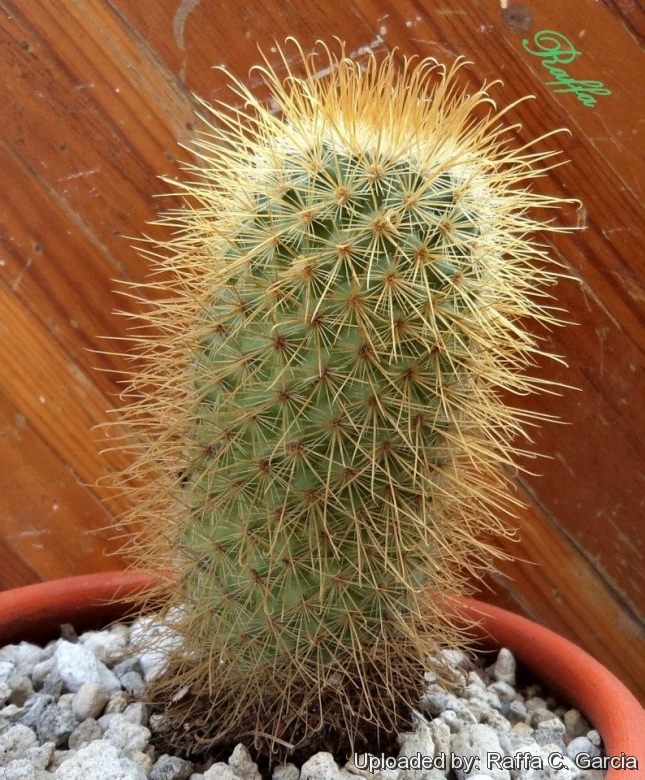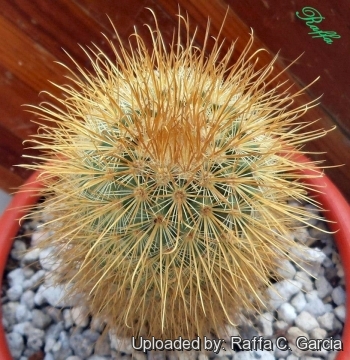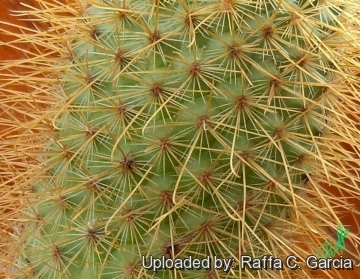




Your support is critical to our success.

Origin and Habitat: Mammillaria magnificaSN|30361]]SN|30361]] is endemic to Mexico, where it is distributed in the states of Morelos and Puebla.
Altitude range: 1,000 to 1,550 metres above sea level.
Habitat and Ecology: This species is probably found in deciduous forest. The threats to this species are unknown.
Synonyms:
- Mammillaria magnifica Franc.G.Buchenau
Description: Mammillaria magnificaSN|30361]]SN|30361]] is a fine but poorly known taxon that form clumps of tall column bristling with yellowish brown, hooked central spines. It is a rapidly growing, clumping species but often distinctly tatty or tired-looking in cultivation. However the plant will reward the skilled growers with ring of fine rose-purple flowers circling the crown of the plant. There are several forms known, some with gold spines, some with red to black spines. The large stem will grow towards the sun, changing direction in just a few weeks if the plant is turned.
Derivation of specific name: The specific epithet magnifica means (lat. Magnificus) gorgeous.
Stems: cylindrical, to 40 cm tall, 5-9 cm in diameter.
Tubercles: Pyramidal or conical, with latex, axils with white wool and bristles.
Central spines: 4-5, sometimes as many as 8, the lowest one hooked and to 15-55 mm long, remainders shorter, strong, straight ,needle-like, yellowish brown to pale brown.
Radial spines: 18-24, straight, glassy white or yellowish, 3-8 mm long.
Flowers: Purplish red or pinkish red circling the crown of the plant, to 17-20 mm long, 11-15 mm in diameter.
Fruits; Club shaped, pink with green tips, 5-22 mm long.
Seeds: Brown.
Bibliography: Major references and further lectures
1) Goettsch, B.K. 2013. Mammillaria magnifica. The IUCN Red List of Threatened Species. Version 2014.3. <www.iucnredlist.org>. Downloaded on 30 January 2015.
2) John Pilbeam “Mammillaria The Cactus File Handbook” Cirio Pub. Services, 01/December/1999
3) Edward Anderson “The Cactus family” Timber Press, Incorporated, 2001
4) James Cullen, Sabina G. Knees, H. Suzanne Cubey "The European Garden Flora Flowering Plants: A Manual for the Identification of Plants Cultivated in Europe, Both Out-of-Doors and Under Glass" Cambridge University Press, 11/August /2011
5) David R Hunt; Nigel P Taylor; Graham Charles; International Cactaceae Systematics Group. "The New Cactus Lexicon" dh books, 2006
6) Urs Eggli, Leonard E. Newton: "Etymological Dictionary of Succulent Plant Names." Birkhäuser 2004
7) Ulises Guzmán, Salvador Arias, Patricia Dávila: "Catálogo de cactáceas mexicanas." Universidad Nacional Autónoma de México, Mexiko-Stadt 2003
8) “Mammillaria magnifica” in: Cactus and Succulent Journal, Volume 77, Ed. 1-6 page 63 2005
9) “Mammillaria magnifica” in: The Journal of the Mammillaria Society, Volumi 20-22
10) Copertina anteriore Mammillaria Society, page 6 1980
11) David Hunt: "A new review of Mammillaria names L−M." In: Bradleya. Jg. 3, 1985, S. 57−58.
12) Cactáceas y Suculentas Mexicanas. Jg. 12, Azcapotzalco, Mexico City 1967, S. 3.

Mammillaria magnifica Photo by: Raffa C. Garcia

Mammillaria magnifica Photo by: Raffa C. Garcia
Cultivation and Propagation: Mammillaria magnificaSN|30361]]SN|30361]] is a great looking small columnar plant that offsets eventually but has nasty hooklets that grab you if you get too close. Itis not particularly difficult on own roots. No special cultural requirements.
Growth rate: It is a rapidly growing, clumping species that will produce wonderful clumps of very heavily spined plants. From seed, it will fill a large pot in just a few years. Offsets are produced freely, and are distributed somewhat randomly. Since the plant can make wide spreading mounds, shallow pots of large diameter will be required as the plant ages.
Soils: It likes very porous standard neutral cactus mix soil.
Repotting: Use pot with good drainage.
Watering: It should be watered generously during the growing season, but do not overwater (Rot prone), keep dry in winter. Water it less than average if in bigger pots, small pots preferred.
Fertilization: Feed with a high potassium fertilizer in summer.
Hardiness: Reputedly sensitive to frost, but less so if kept on the dry side prior to, and during, cold weather. However warmth throughout the year will increase the grower's success (8-12°C during rest season).
Exposition: Outside bright, hot conditions or afternoon shade, inside it needs bright light, and some direct sun. Strong light encourages flowering and heavy wool and spine production.
Uses: It is an excellent plant for container growing. It always looks good and stays small.
Pests & diseases: It may be attractive to a variety of insects, but plants in good condition should be nearly pest-free, particularly if they are grown in a mineral potting-mix, with good exposure and ventilation. Nonetheless, there are several pests to watch for:
- Red spiders: Red spiders may be effectively rubbed up by watering the plants from above.
- Mealy bugs: Mealy bugs occasionally develop aerial into the new growth among the wool with disfiguring results, but the worst types develop underground on the roots and are invisible except by their effects.
- Scales: Scales are rarely a problem.
- Rot: Rot is only a minor problem with cacti if the plants are watered and “aired” correctly. If they are not, fungicides won't help all that much.
Propagation: Division, direct sow after last frost or (often) graft. Seeds germinate in 7-14 days at 21-27° C in spring, remove the glass cover gradually as the plants develops and keep ventilated, no full sun for young plants! To make a cutting twist off a branch and permit it to dry out a couple of weeks, lay it on the soil and insert the stem end partially into the soil. Try to keep the cutting upright so that the roots are able to grow downward.
| Your Actions | |
|---|---|
| Back to Mammillaria index | |
| Back to Cactaceae index | |
 |
Back to Cacti Encyclopedia index |
Privacy stantement - Terms and conditions - How to cite - About us - Feedback - Donate



